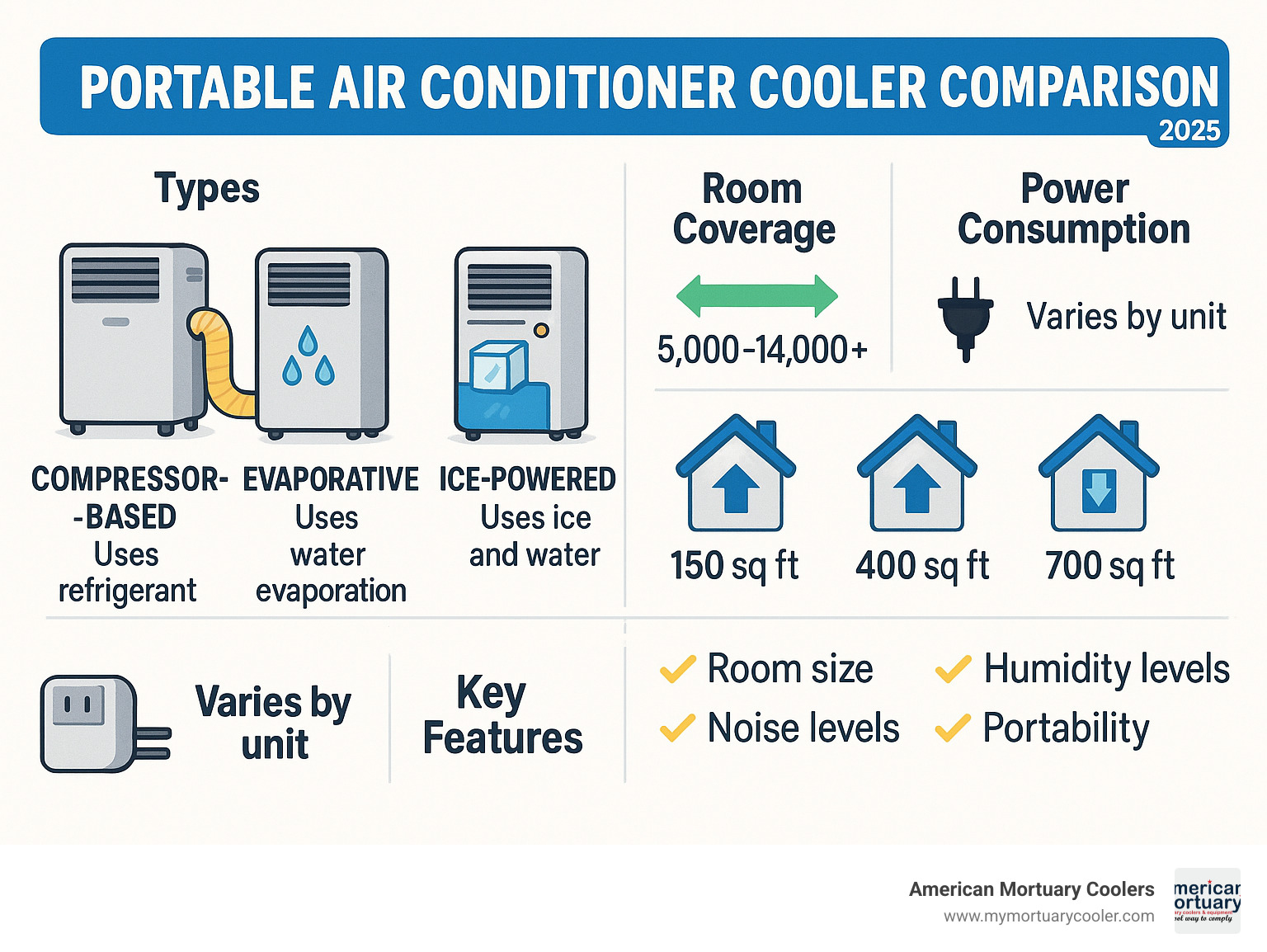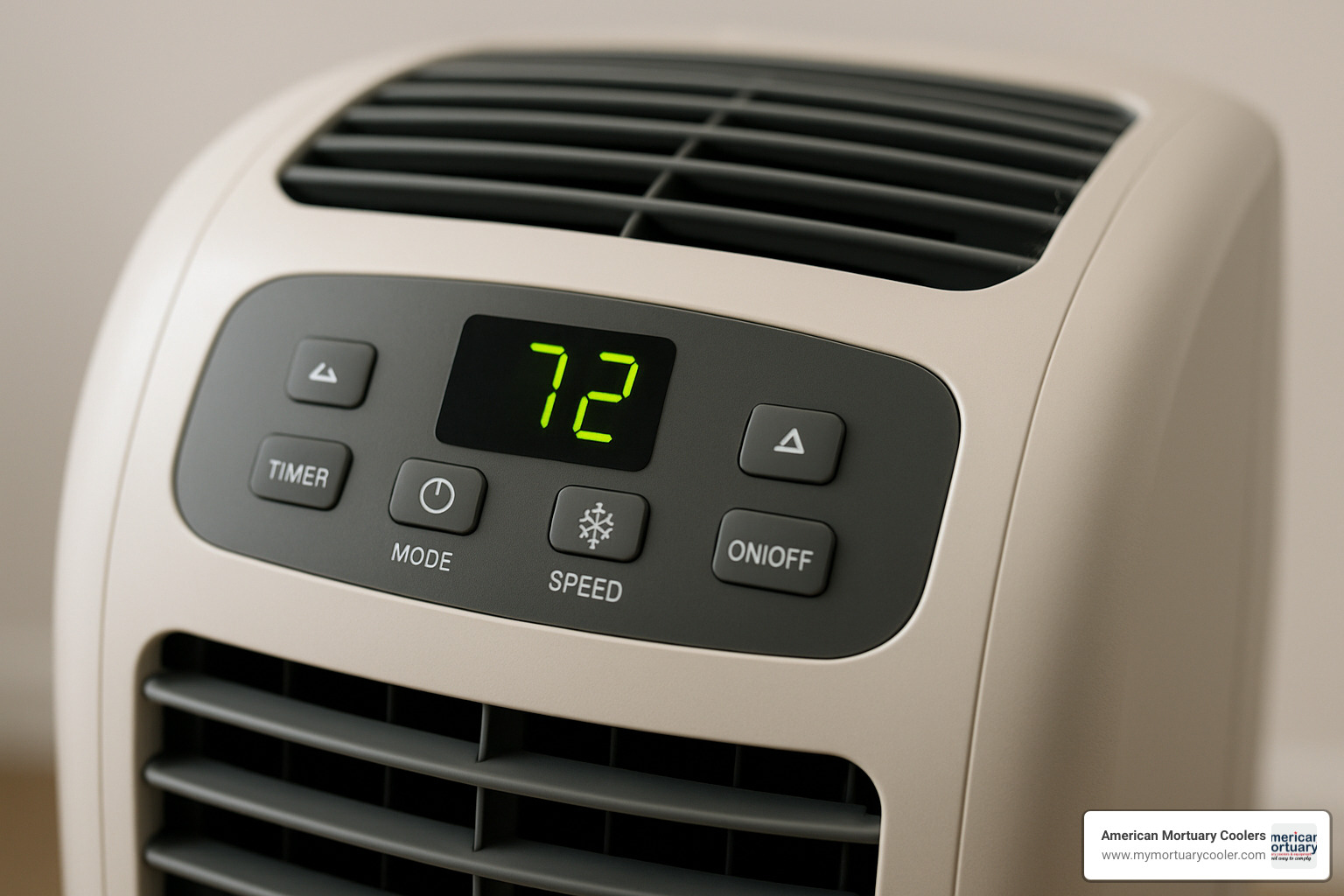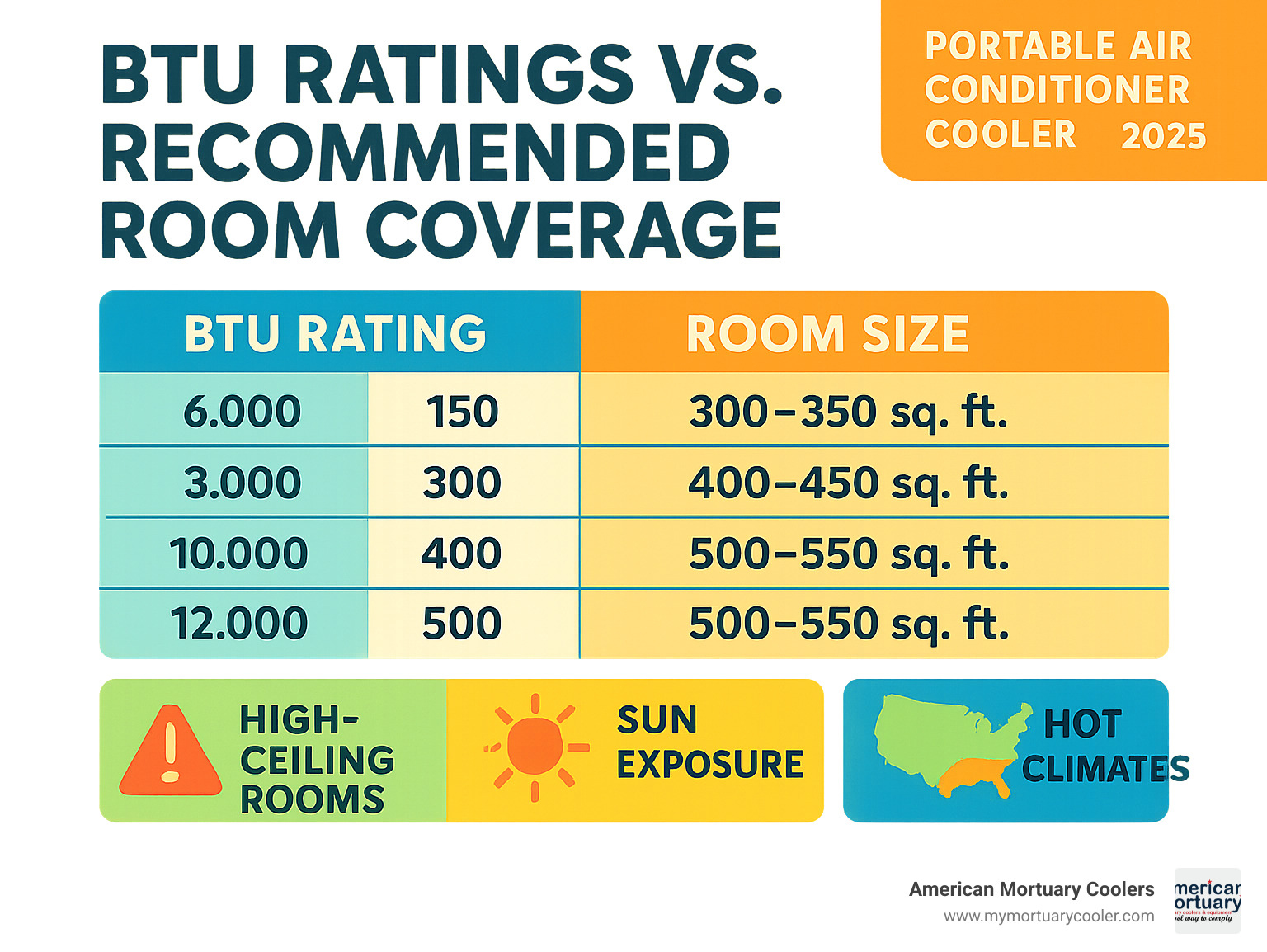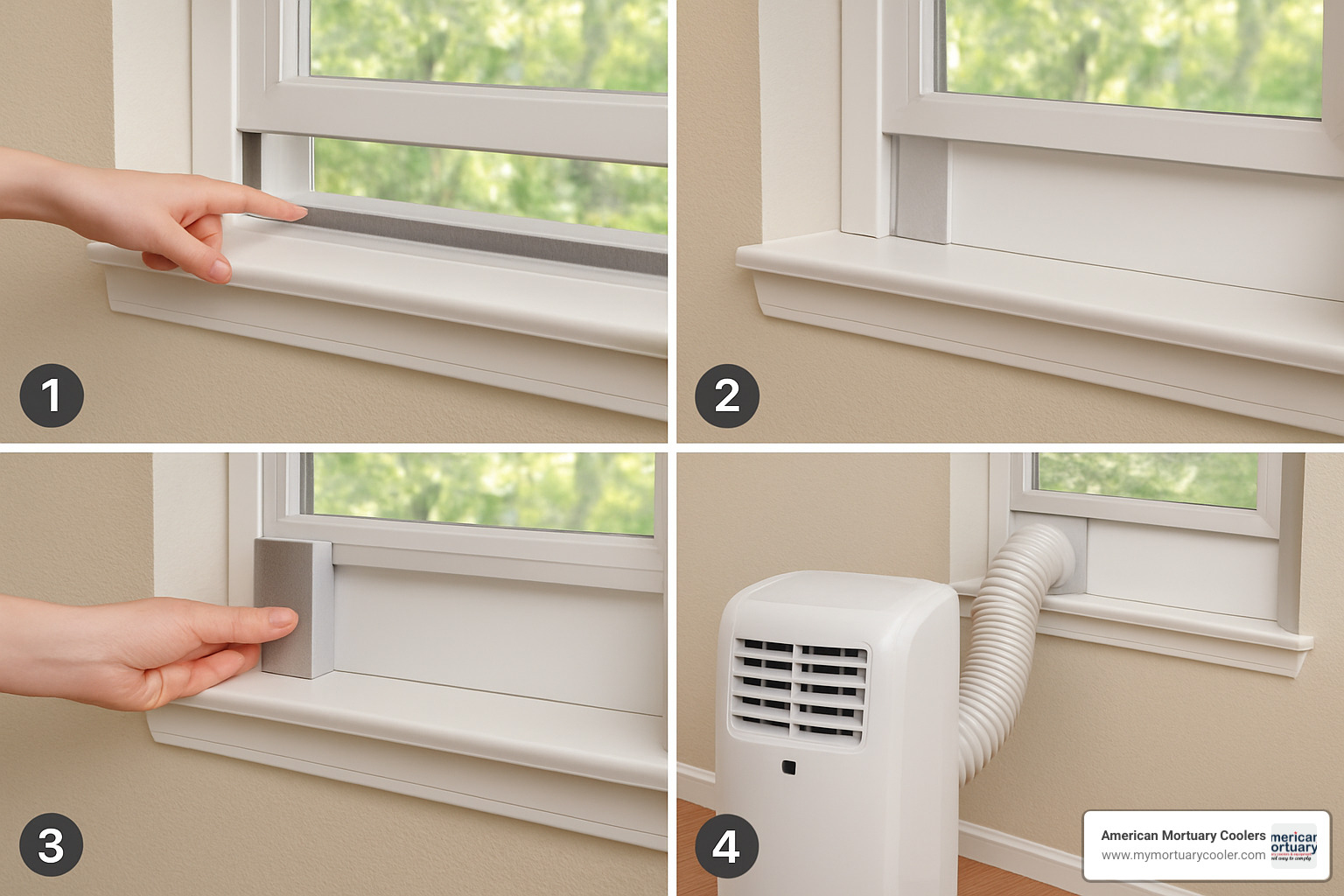Why Portable Air Conditioner Coolers Are Essential for Modern Cooling
A portable air conditioner cooler is a self-contained cooling unit that can be moved from room to room without permanent installation. These versatile units offer instant relief from heat while providing the flexibility to cool specific areas as needed.
Key Types of Portable Air Conditioner Coolers:
- Compressor-based units - Use refrigerant and exhaust warm air through a hose (5,000-14,000+ BTU)
- Evaporative coolers - Use water evaporation to cool air, work best in dry climates
- Ice-powered models - Deliver air up to 35°F cooler using ice and water
- Battery/solar units - Operate off-grid for camping, RVs, and outdoor use
Coverage Areas:
- 5,000 BTU = up to 150 sq ft
- 10,000 BTU = up to 400 sq ft
- 14,000 BTU = up to 700 sq ft
The portable air conditioner market ranges from $119 entry-level units to $900+ premium models. Energy-efficient units like the Coolzy-Go use just 340 watts - 70% less electricity than standard portable ACs.
I'm Mortuary Cooler, a national-level supplier specializing in commercial cooling solutions including portable air conditioner cooler systems for specialized applications. My experience with temperature-controlled environments helps identify the key factors that separate effective portable cooling units from disappointing purchases.

Know your portable air conditioner cooler terms:
How Does a Portable Air Conditioner Cooler Work?
Understanding how your portable air conditioner cooler works is key to choosing the right unit and getting the most value. Most units operate on three main principles: refrigeration cycles, evaporative cooling, and heat exchange systems.
Compressor-based units use a refrigeration cycle similar to your kitchen refrigerator. A compressor pressurizes refrigerant (usually R-134a), which cycles between liquid and gas states. As it evaporates, it absorbs heat from your room's air. When it condenses, it dumps that heat outside through the exhaust hose.
This process handles dehumidification too, making these units lifesavers in humid climates where evaporative coolers would create swamp-like conditions.
BTU (British Thermal Units) tells you cooling power, but SACC (Seasonally Adjusted Cooling Capacity) ratings give you the real story about performance. A unit boasting 12,000 BTU might only deliver 8,000 BTU SACC when accounting for heat infiltration through the exhaust hose.
The Energy Efficiency Ratio (EER) is your wallet's best friend. Higher EER means more cooling for less electricity. Energy Star models exceed minimum standards, keeping power bills in check.
Modern portable air conditioner coolers feature smart thermostats and Wi-Fi controls that switch between cooling, dehumidification, and fan modes based on room needs.
Compressor vs. Evaporative Fundamentals
Compressor ACs are reliable workhorses. The compressor forces refrigerant through evaporator and condenser coils. As refrigerant evaporates in the indoor coil, it absorbs heat from your air. Then it travels to the outdoor coil where it condenses and dumps heat outside.
These units work anywhere, anytime - humid basements or desert heat.
Evaporative coolers pull warm air through water-soaked pads. The phase change from liquid to vapor creates cooling - like feeling chilly when stepping out of a pool on a breezy day.
Evaporative cooling only works in dry climates with humidity below 50%. In the right conditions, they drop temperatures by 15-30°F while using a fraction of the electricity.
Energy & Environmental Impact
Power draw varies wildly between technologies. Standard portable ACs typically use 1,100+ watts, but efficient models like the Coolzy-Go use just 340 watts - 70% less electricity.
Most units use R-134a refrigerant with a Global Warming Potential (GWP) of 1,430. Newer refrigerants like R-32 have much lower GWP ratings.
The Coolzy-Go Portable Air Conditioner represents efficient cooling's future, creating personal microclimates where you need them most.
Portable Air Conditioner Cooler Types Explained
When shopping for a portable air conditioner cooler, you'll encounter several categories that work differently. The key is matching the cooling technology to your specific situation.
Compressor-Based Portable Air Conditioner Coolers
These are the workhorses using refrigerant and a compressor to actively remove heat from your space.
The big decision is single-hose versus dual-hose design. Single-hose units are cheaper but create problems by sucking air out of your room to cool the compressor, pulling hot outdoor air back in through gaps.
Dual-hose models solve this by using separate hoses for intake and exhaust, improving efficiency by 30-40%. They cost more upfront but save money on electricity.
Modern units often double as heaters, switching refrigerant flow for winter warmth. Inverter technology in premium models adjusts compressor speed smoothly instead of cycling on and off.
Noise varies dramatically. Budget models can hit 50-60 decibels, while premium inverter units whisper at 40 decibels. For bedroom use, the extra cost for quiet operation pays off.
Evaporative & Ice-Powered Portable Air Conditioner Coolers
Evaporative coolers work like nature's air conditioning, cooling air through water evaporation. They use about 75% less electricity than compressor units but only work in dry climates where humidity stays below 50%.
Ice-powered models use ice and water to blast air up to 35°F cooler than surrounding temperature. They're perfect for tailgating where you need both cold drinks and personal cooling.
Evaporative cooling is simple - no complex refrigerant systems, no exhaust hoses, and minimal electricity usage. They add beneficial humidity to dry indoor air instead of removing it.
The Ultimate Guide to Swamp Air Conditioner & Portable Units covers when evaporative cooling makes sense.
Off-Grid & Outdoor-Ready Models
Battery-powered and solar-compatible units have opened up cooling possibilities impossible just years ago. The Coolzy-Go pioneered this space with 340-watt power consumption - low enough for batteries, small solar setups, or portable generators.
Rugged outdoor models feature weather-resistant housings and mounting options for RVs, boats, and work sites. They cost 50-100% more than indoor units but provide cooling where traditional AC isn't an option.
Key Features & Buyer's Checklist

Choosing the right portable air conditioner cooler requires focusing on features that matter for your specific situation.
The BTU rating gets attention, but SACC ratings tell you what your unit will actually deliver. A 12,000 BTU unit might only provide 8,000 BTU of real cooling once you account for heat infiltration.
Energy efficiency directly impacts your monthly bills. Look for high EER ratings and Energy Star certification. Check power consumption in watts - newer models use 30-40% less electricity than older designs.
Modern Wi-Fi controls let you start cooling before arriving home. Multi-mode operation switches between cooling, dehumidifying, and fan modes based on needs.
Weight and caster quality matter for mobility. Noise ratings under 50 decibels work for sleeping areas. Warranty coverage varies from 1 to 5 years.

Must-Have Specs for Small Rooms (≤300 sq ft)
Small spaces need 5,000-8,000 BTU units that won't overwhelm your space or electric bill. Prioritize timer functions and sleep mode for energy savings. Washable filters save money on replacements.
Compact design and quiet operation under 50 decibels become essential for bedroom use. Budget units start around $200, but smart controls and quiet operation justify spending $300-400.
Mid-Size to Large Room Essentials (300-700 sq ft)
Larger spaces demand 10,000-14,000 BTU units with dual-hose designs to prevent negative pressure issues. Auto-swing louvers distribute cool air evenly. Integrated heating provides year-round climate control.
Self-evaporating technology reduces maintenance. Heavy-duty casters support increased weight. Premium units feature inverter compressors that reduce noise and improve efficiency by 20-30%.
Pro Tips to Maximize Efficiency
Proper setup improves cooling performance by 30-50%. Window kit sealing prevents air leaks. Minimize exhaust hose length and avoid kinks. Position units away from heat sources.
Programmable schedules prevent cooling empty rooms. Clean filters monthly during heavy use. Close doors and windows to contain conditioned air. Ceiling fans improve comfort without extra cooling.
Performance, Coverage & Cost Comparison
When shopping for a portable air conditioner cooler, smart buyers look beyond sticker price to running costs, cooling effectiveness, and longevity.
That 12,000 BTU rating might only deliver 8,000 BTU of actual cooling due to heat infiltration. SACC ratings give you honest performance expectations.
Portable Air Conditioners & Air Coolers – Best Buy showcases options from basic units to premium whisper-quiet models.
Budget Segment Snapshot
The $119-$250 range offers 5,000-7,000 BTU units for small bedrooms or offices. These typically weigh 50-65 pounds and produce 50-55 decibels of noise. Most use single-hose designs with basic manual controls.
Trade-offs include lower EER ratings meaning higher electricity bills. Stick with brands offering at least 2-year warranties since ultra-cheap units sometimes fail their first summer.
Mid-Range Winners
The $250-$450 range delivers the sweet spot with smartphone app control, dual-hose designs, and 8,000-12,000 BTU capacity. Smart technology and programmable schedules can reduce operating costs by 20-30%.
Many include integrated heating for year-round use. Customer satisfaction jumps to 4.0-4.4 out of 5 stars in this price range.
Premium & Specialty Units
$450-$900+ units feature inverter compressor technology with continuous speed adjustment. Noise drops to 40-45 decibels - library-quiet operation.
The Coolzy-Go at $349 consumes just 340 watts while delivering serious cooling. Over a full summer, efficiency savings can offset higher purchase prices.
Specialty models like the Neoamico outdoor unit ($895) handle weather that destroys indoor-only models. For frequent users, premium features are practical investments in comfort and efficiency.
Installation, Maintenance & Real-World Use Cases

Proper setup makes the difference between staying cool and wasting money. Small installation mistakes can cut cooling power by 30% or more.
Window kit setup is crucial. Seal everything with weather stripping - even tiny gaps let warm air sneak back in. Keep exhaust hoses short and straight - every bend makes your compressor work harder.
Filter cleaning is the easiest maintenance task people skip most. Clean filters monthly during heavy use - it takes five minutes and improves cooling by 15%.
An Essential Guide to Comparing Evaporative Portable Air Coolers covers specific maintenance needs.
Indoor Setup in Apartments & Dorms
Renters need no-drill kits that create tight seals without permanent changes. Position units away from bedrooms for noise management and use rubber pads to stop vibrations.
Your unit needs 12-18 inches of clearance around air intake. Smart scheduling helps with noise and energy costs - run during the day, switch to fan-only at night.
Outdoor, RV & Camping Scenarios
Battery-powered units like the Coolzy-Go run on 12V systems. Factor in startup surge power - most units need 2-3 times running wattage when starting. Size battery banks for 4-8 hours runtime.
The IcyBreeze ice-powered model solves power problems by using ice instead of electricity - perfect for tailgating and camping.
Troubleshooting Common Issues
Water leaks usually mean clogged drains or unlevel units. Weak cooling points to airflow problems - clean filters first, then check for blocked vents. Error codes often reset by unplugging for 30 seconds.
Exhaust hose problems are critical - kinked hoses dump hot air into your room instead of outside.
Frequently Asked Questions about Portable Air Conditioner Coolers
What room size will a 10,000 BTU portable air conditioner cooler handle?
A 10,000 BTU portable air conditioner cooler works well for 250-400 square feet, but actual coverage depends on more than square footage. Cooling a sunny bedroom with high ceilings differs completely from a shaded basement room.
For typical rooms with 8-foot ceilings and average insulation, expect effective cooling for 350 square feet. With sun exposure, high ceilings, or heat-generating appliances, plan for the lower range.
The SACC rating tells you more than BTU numbers. That 10,000 BTU unit might only deliver 7,000-8,000 BTU of actual cooling due to heat infiltration through exhaust hoses.
Do portable air conditioner coolers need to vent outside?
Absolutely yes for compressor-based units. Your portable air conditioner cooler pulls heat from your room and dumps it elsewhere. Without proper venting, you're running a heater and air conditioner simultaneously.
That exhaust hose carries hot air from condenser coils outside where it belongs. Window kit installation matters - even small gaps let hot outdoor air sneak back in.
Evaporative coolers work differently - they need ventilation to let humid air escape while fresh air enters.
Can I run a portable air conditioner cooler on solar panels?
Yes, but most traditional portable ACs need 1,000+ watts. For a 1,200-watt unit, you'd need a 1,500+ watt solar array and massive battery bank - a $3,000-5,000 solar setup.
Ultra-efficient units like the Coolzy-Go use just 340 watts. A modest 500-watt solar panel setup can run this during sunny hours with reasonable battery storage.
Evaporative coolers using only 100-200 watts make solar operation much more practical for basic RV solar setups.
Conclusion
Finding the perfect portable air conditioner cooler becomes manageable when you focus on what matters. The sweet spot for most buyers sits in the $250-$450 mid-range category where smart features meet reliable cooling power.
Energy savings add up fast. Units like the Coolzy-Go using 70% less electricity put hundreds of dollars back in your pocket over five years. Choose efficiency over the cheapest upfront price.
Today's portable cooling market offers solutions for every need - battery-powered units for camping, dual-hose models for apartments, evaporative coolers for dry climates. The key is matching technology to your specific situation.
At American Mortuary Coolers, we've perfected temperature control across challenging environments from Tennessee's humid summers to varied climates in Atlanta, Chicago, Dallas, Los Angeles, and New York. Our experience with precision cooling shows that the right equipment, properly matched to your needs, makes all the difference.
The industry keeps improving with quieter operation, better efficiency, and smartphone controls. Whether you need spot cooling for a home office, backup comfort during repairs, or off-grid cooling for trips, there's a portable solution designed for your situation.
Ready to choose? Our Ultimate Checklist for Choosing the Best Portable Air Cooler guides you through the final decision process. Stay cool year-round with confidence in your portable air conditioner cooler choice.
















